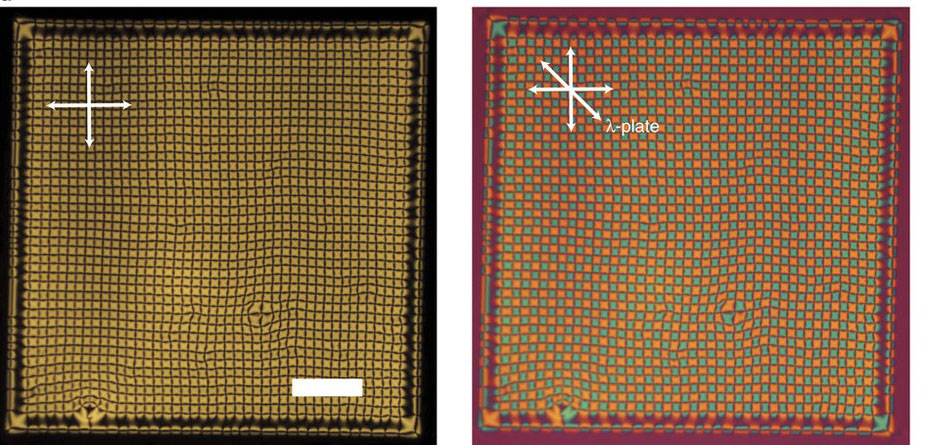ネマチック液晶における再構築可能なトポロジカル欠陥ネットワークの広範囲にわたる自己組織化
Large-scale self-organization of reconfigurable topological defect networks in nematic liquid crystals
2016年11月7日 Nature Communications 7 : 13238 doi: 10.1038/ncomms13238

ネマチック液晶で普遍的に観察される構造としてトポロジカル欠陥が古くから知られている。欠陥は、コロイドや超分子の自己組織化テンプレート・マニピュレーション、光渦の発生などに応用できるばかりでなく、ソフトマターの典型的なモデル系として、複雑系の基本的理解を行う上で重要である。通常、欠陥を空間的・時間的に安定に存在させるためには、表面によるフラストレーションが必要であり、そうでなければ弾性エネルギーのコストが大きいため系は緩和してしまう。これまで、トポロジカル欠陥の安定化の多くは、表面リソグラフィなどによってトップダウン的になされている。本研究では、イオン性不純物を添加するボトムアップ的なアプローチによって、こうした手法とは全く異なり表面のパターニングを一切行うことなく、多数のトポロジカル欠陥をネットワーク的に安定化させることに成功した。ここでは、交流電圧による分子の再配向により、ドープしたイオンを絶縁性の高いフッ素ポリマー界面に周期的に蓄積させることで、トポロジカル欠陥を二次元正方格子状に配列させる。このように自己組織的に得られたトポロジカル欠陥配列は再構築と調節が可能であることを実証する。
Yuji Sasaki, V.S.R. Jampani, Chiharu Tanaka, Nobutaka Sakurai, Shin Sakane, Khoa V. Le, Fumito Araoka and Hiroshi Orihara
Corresponding Authors
Topological defects in nematic liquid crystals are ubiquitous. The defects are important in understanding the fundamental properties of the systems, as well as in practical applications, such as colloidal self-assembly, optical vortex generation and templates for molecular self-assembly. Usually, spatially and temporally stable defects require geometrical frustration imposed by surfaces; otherwise, the system relaxes because of the high cost of the elastic energy. So far, multiple defects are kept in bulk nematic liquid crystals by top-down lithographic techniques. In this work, we stabilize a large number of umbilical defects by doping with an ionic impurity. This method does not require pre-patterned surfaces. We demonstrate that molecular reorientation controlled by an AC voltage induces periodic density modulation of ions accumulated at an electrically insulating polymer interface, resulting in self-organization of a two-dimensional square array of umbilical defects that is reconfigurable and tunable.

